Election 2018 exit poll analysis: Voter turnout soars, Democrats take back the House, ABC News projects
Donald Trump and control in Congress is front and center in this election.
As the polls have closed in many states, preliminary exit poll results show a deep divide along party lines:
National Exit Poll
Donald Trump and control of Congress are front and center in this election, and preliminary results from the state and national exit polls touch on both of them:
In results so far, 44 percent of voters approve of Trump’s job performance, while 55 percent disapprove.
And while the House races will be fought district by district, voters by 53-43 percent say they’d rather see the Democrats than the Republicans in control of the House after this election.
Antipathy toward Trump doesn’t reach majority support for impeachment – 41 percent of voters support impeaching the president and removing him from office, with 55 percent opposed. Still, 39 percent say they cast their ballots to show opposition to Trump, vs. 26 percent who say they voted to show him support. (33 percent say he didn’t figure in their vote.)
There are vast divisions among groups on Trump and control of Congress, and voters recognize today’s political polarization. Seventy-seven percent say Americans are becoming more politically divided, while just 8 percent see greater unity; 13 percent see no change.

Indeed, even with the economy its best in decades by many measures, just 41 percent say the country is headed in the right direction, while 56 percent say it’s seriously off on the wrong track. There’s a huge gulf between Republicans and Democrats on the question, but among independents, often swing voters, 58 percent say wrong track vs. 39 percent right direction.
While preliminary exit poll results indicate a preference for Democratic control of the House, neither party is beloved. Voters divide 50-46 percent in favorable vs. unfavorable views of the Democratic Party. The GOP fares worse – 43-54 percent, favorable-unfavorable. Nancy Pelosi, a Republican bugaboo in the campaign, trails her party’s favorability rating - and Trump's approval rating - at 31-55 percent, favorable-unfavorable.
In one more eye-opening preliminary result: 51 percent of voters today say the government has not done enough to protect this election from foreign interference.
In terms of group sizes – which can change, these are preliminary results only:
Party ID: Democrats account for 38 percent of voters in exit poll results so far, Republicans for 32 percent and independents for 30 percent. That compares with 36-37-27 percent in 2014, and 37-33-29 percent in 2016.
Ideology: Liberal-moderate-conservative group sizes in results so far are 27-38-36 percent. That compares with 22-39-38 percent in the 2014 midterms. (And 26-38-36 percent in 2016.)
Sex: Women account for 52 percent of voters in preliminary results, matching their previous high in a midterm from 2010.
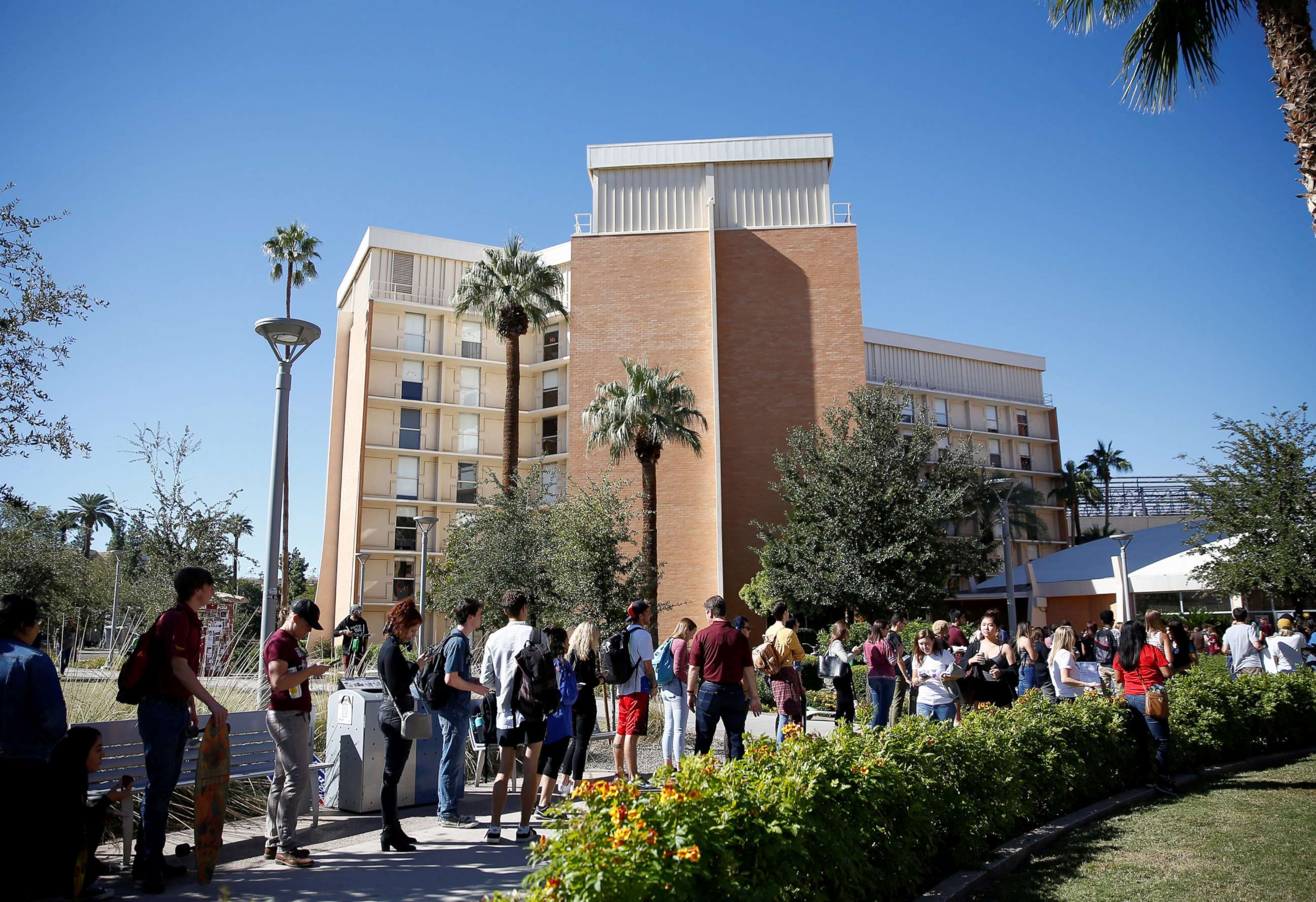
Key Issues
Among key issues in the campaign – beyond Trump himself – preliminary exit poll results indicate the following:
Immigration: With the Central American caravan drawing broad attention in the campaign, voters divide on Trump’s immigration policies – 48 percent say they’re too tough, 32 percent say they’re about right and 16 percent say they’re not tough enough.
Health care: Voters by 58-34 percent pick the Democratic Party over the Republicans as more likely to protect health care for people with pre-existing conditions, another central focus of the 2018 campaign.
Further, given a choice of four issues, 41 percent pick health care as the top issue facing the country, compared with 21 percent for the economy, 23 percent immigration and 11 percent gun policy. (We’ll look at vote preferences in each group as the night proceeds.)
Kavanaugh: Any impact of the controversial confirmation of Brett Kavanaugh to the Supreme Court may come down to state-to-state races. Nationally, the country divides – 43 percent support his confirmation, 48 percent oppose it in preliminary exit poll results.
Tax and trade: Two of the president’s signature economic policies get a mixed reception. Fewer than a third of voters, 28 percent, say they’ve been helped by the Trump tax law (45 percent no impact, 23 percent hurt by it.) And just 25 percent say Trump’s trade policies have helped their local economy. 31 percent say they’ve hurt, 36 percent say they've had no effect.
Women: Women account for 53 percent of voters in preliminary exit poll results, numerically a record midterm high (albeit by just 1 point from 2010). They’re voting for Democratic House candidates by 60-39 percent. And there’s a tremendous gender gap in views of president Trump’s work in office: While men voting today divide 50-49 percent on Trump, approve-disapprove, that goes to 39-60 percent among women voters. And while 57 percent of men approve of Kavanaugh’s confirmation, just 43 percent of women agree.
Sharp gender differences extend elsewhere. Voters by 78-20 percent call it important to elect more women to public office; 53 percent of women call it “very” important, vs. do 37 percent of men. That may play out in the unusual number of races including female candidates this year.
And 84 percent of voters today call sexual harassment a serious problem in the United States, including 47 percent who call it very serious. 52 percent of women vs. 40 percent of men call sexual harassment a very serious problem. In an even bigger gap, 64 percent of Democrats call it very serious, vs. 40 percent of independents and 29 percent of Republicans.
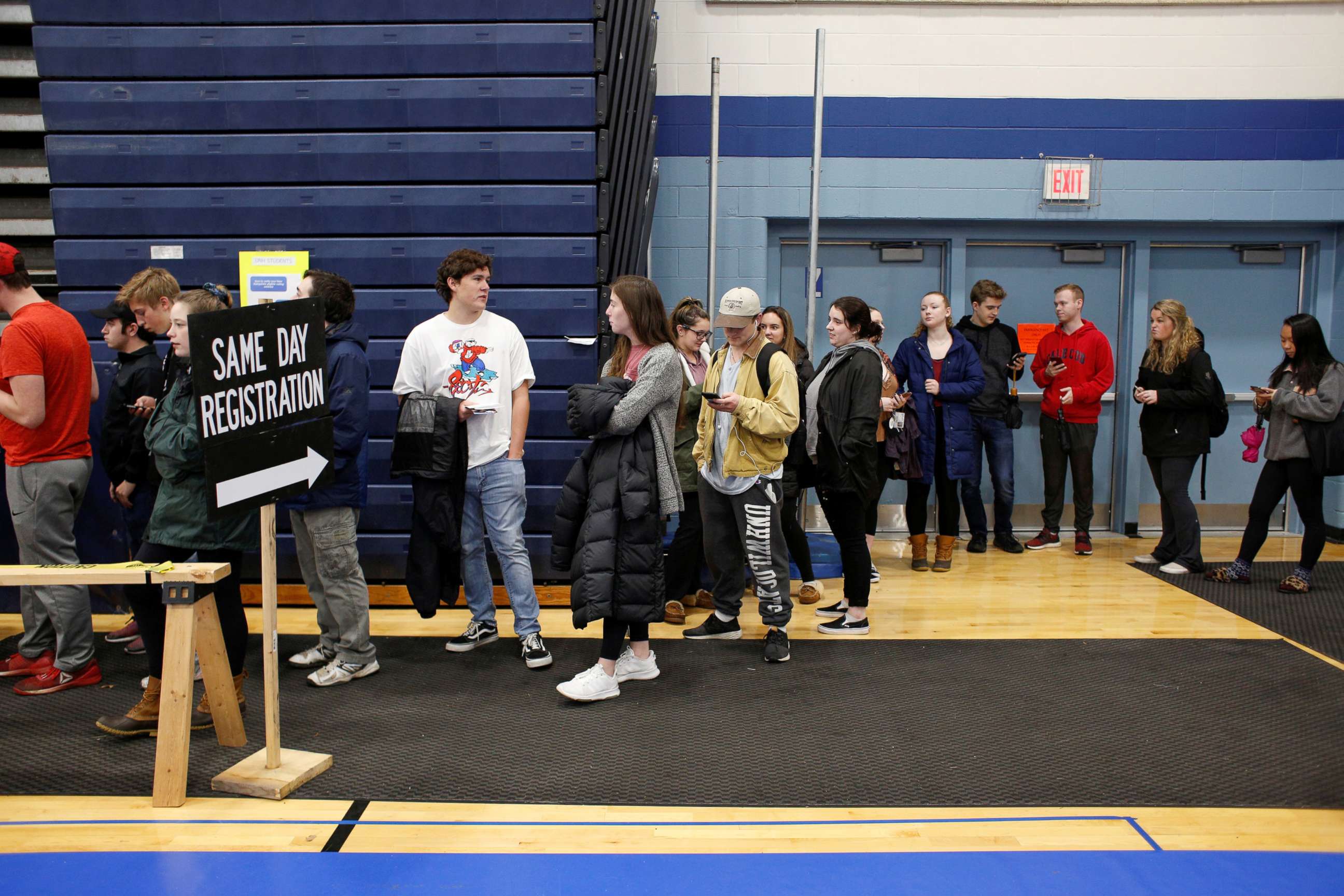
More On Groups And Issues
Race: Turnout by racial and ethnic minorities is key to Democrats’ chances in many contests. Preliminary exit poll results can change, but in these early results nonwhites account for 29 percent of voters nationally; as noted, the highest in any midterm was 25 percent in 2014. That nonwhite total includes 12 percent blacks and 12 percent Hispanics. The previous highs in midterm elections were 13 percent for blacks, in 2014; and 8 percent for Hispanics, in 2006, 2012 and 2014 alike.
With black candidates in several high-profile races, voters nationally by 71-24 percent say it’s important to elect more racial and ethnic minorities to public office; 44 percent say it’s very important. It’s very important to 61 percent of nonwhites, compared with 38 percent of whites.
There’s also a sharp division – as much political as racial and ethnic – in whether voters think whites are favored over minorities, minorities are favored over whites, or no group is favored. Among Democrats, 71 percent think whites are favored over minorities. Among Republicans, just 10 percent agree.
Voting: Ballot access is a related issue: In these preliminary results, the public by 54-36 percent sees voter suppression as a bigger concern than vote fraud.
Age: Will young and first-time voters make a difference this year? Patterns of when people vote mean this can change, but in preliminary results 18- to 29-year-olds account for 13 percent of voters nationally today; it was 11 percent in 2014, when they backed Democrats for House by a 12-point margin.
Economy: 68 percent of voters say the economy is in excellent or good condition, up dramatically from 36 percent just two years ago, albeit far below the peak, 85 percent, in 2000. Many fewer, though, say their own financial situation has improved in the past two years: 35 percent, compared with 30 percent two years ago.
What typically matters most is people who say they’re worse off: 14 percent in today’s preliminary results. It was 26 percent in 2014; what mattered is that they favored Republicans for House – then voting against the president’s party – by 67-31 percent.
Mueller/Election Security: In the investigation still hanging over the Trump White House:
Voters divide on Robert Mueller’s handling of his investigation, 42-46 percent, approve-disapprove.
Voters by 54-41 percent say the Mueller investigation is mostly politically motivated rather than justified.
Gun Ownership: 47 percent of voters live in gun-owning households in preliminary exit poll results.
Stricter Gun Control Measures: 60-35 percent, support-oppose. Among those in gun-owning households, 42-52 percent.
Veterans: 14 percent of voters, preliminarily.
White Evangelical Christians: 27 percent of voters, preliminarily. The previous midterm peak was 27 percent in 2014. One of the most Republican groups, they voted 83-16 percent for House candidates in 2016, and 78-21 percent in 2014.
LGBT Voters: 6 percent of all voters in results so far, compared with 4 percent in the last two elections.
Independents – often swing voters – are voting 55-41 percent for Democratic vs. Republican House candidates in preliminary exit poll results. In 2016, independents backed Donald Trump by 47-41 percent, and they voted Republican by a 14-point margin in the last midterms in 2014.
Young voters (18-29) are voting 68-31 percent, Democratic-Republican. That vast 37-point margin compares with a 21-point margin for Hillary Clinton in 2016 and a 12-point margin for Democratic House candidates among under-30s in 2014.
In a continuing demographic trend, nonwhites make up 29 percent of voters today, the most on record for a midterm in exit polls since 1982.They’re voting Democratic by 77-22 percent, including 69-29 percent among Hispanics, the widest Democratic margin in midterms since 2006, and 90-9 percent among blacks.
Suburban women were a focus of election coverage. They’re dividing 54-44 percent between Democratic and Republican House candidates. Among women overall, it’s 60-39 percent.
Moderates backed Clinton by 13 points in 2016 and voted Democratic by a similar margin, 10 points, in 2014. Today moderates are voting 63-34 percent, Democratic-Republican, a 29-point margin in preliminary exit poll results.
Twenty-seven percent of voters nationally are liberals - if it holds, a record high in any election in exit polls since 1976 (albeit by a single point from 2016). Conservative voters represent 35 percent of the electorate, compared with a midterm record of 42 percent in 2010.
Republican candidates are overwhelmingly winning voters who say they’ve become better off financially under Trump’s presidency – but these are just 35 percent of voters. Among those whose financial situation is unchanged, the vote is 71-28 percent, Democratic-Republican.
There’s been much attention paid to voters who say they’re either showing support for Trump or opposition to him. Also of interest – the 33 percent who say Trump is not a factor in their vote. They’re dividing 46-51 percent, Democratic-Republican.
Evangelical white Christians, a GOP mainstay, are voting 22-75 percent, Democratic-Republican, in the national House vote, their typical level.
Clinton won college-educated white women by 10 points in 2016, and this group voted +2 points Republican in 2014. Now they’re favoring Democratic House candidates by 23 points, 61-38 percent.
Across the political spectrum, non-college white men, 20 percent of voters, are going 34-65 percent, Democratic-Republican in their national House vote. That’s +31 points Republican, compared with their +46 points for Trump in 2016 and +35-point Republican vote in 2014.
Voters who are focused on the economy are split 35-62 percent, Democratic-Republican. Among those concerned more with health care, that goes to a 77-21 percent Democratic advantage.
Further, they’re voting for Democratic rather than Republican House candidates nationally by more than 2-1, 67-32 percent, a record margin for this group in exit polls – presidential and midterms alike – in available data back to 1990.
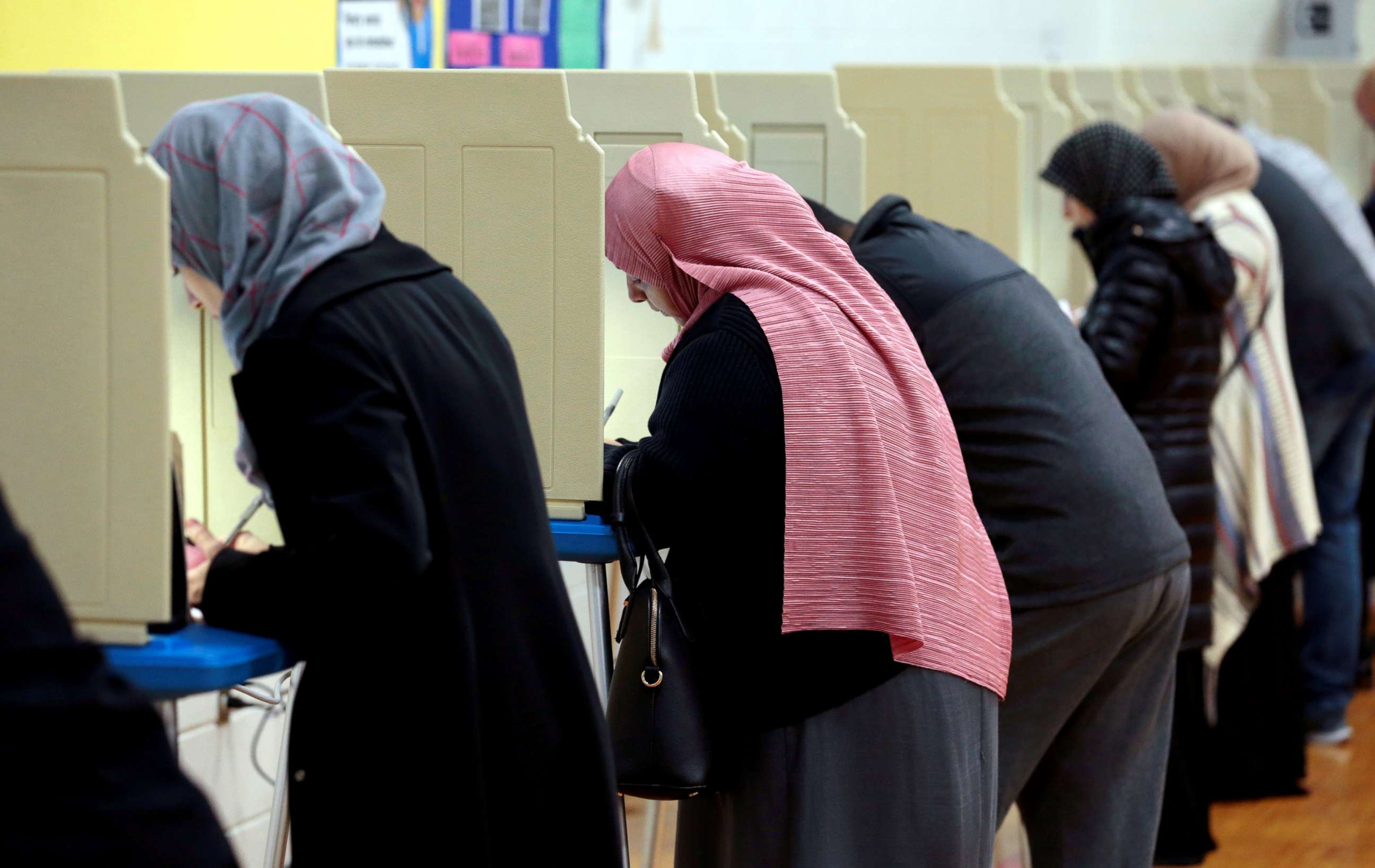
North Dakota Senate race
Democrat Heidi Heitkamp has conceded the North Dakota Senate race to Republican Kevin Cramer.
Forty-seven percent of voters said that Heitkamp’s (D) vote against Kavanaugh was important in their vote, and they went for Cramer by nearly 2-to-1: 38-62 percent.
Heitkamp won independents (38 percent of voters), but only by a 10-point margin, not enough with Republicans accounting for 40 percent of the electorate. Predictably, they voted 92-7 percent for Cramer.
Donald Trump won North Dakota by a 36-point margin in 2016, 63-27 percent. His approval rating there today is 60-39 percent, the second-highest approval rating across exit poll states. Even so, 47 percent of voters said that Trump was not a factor in their vote, versus 31 percent of voters who said they’re casting a ballot to support him and 20 percent who said they’re voting to oppose him.
Heitkamp has a 43-53 percent favorability rating -- 10 points under water -- and is seen as too liberal by 47 percent of voters. Cramer’s favorability rating is better, 53-42 percent, while 40 percent see him as too conservative.
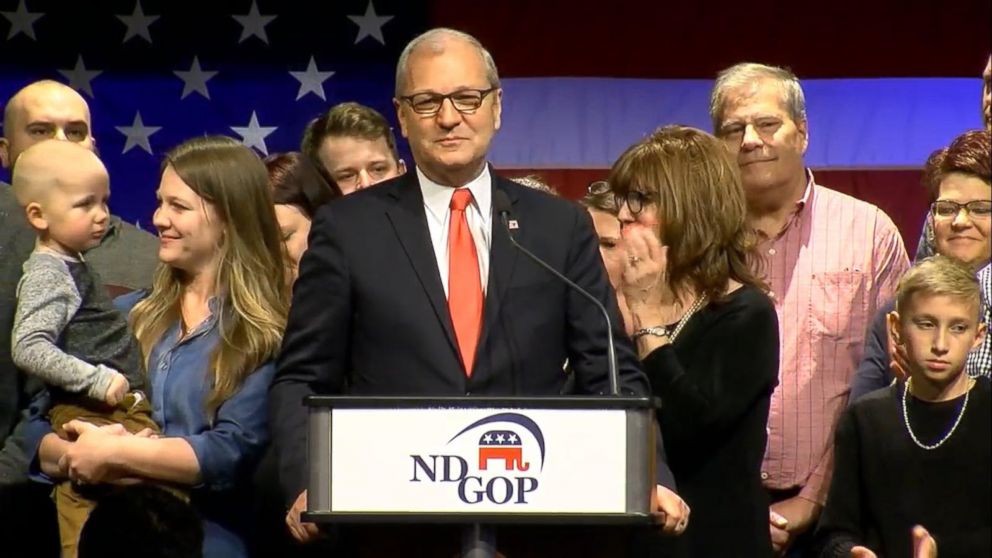
More voters in this farm state said that Trump’s trade policies have hurt their local economy, 36 percent, than helped, 23 percent; 34 percent see no impact. And a majority, 52 percent, said the tax cuts have had no impact on their finances. Thirty-nine percent said they’ve become better off financially since Trump took office.
Health care ranks first as the top issue (out of four). And voters divide 46-42 percent on whether the Democrats or the Republicans would better protect coverage for those with pre-existing conditions.
Changes to voter ID laws raised concerns about Native American’s voting access. In preliminary results, Native Americans account for 2 percent of North Dakota voters, vs. 4 percent in 2008 (the most recent exit poll data in the state).
The vote in preliminary data is 38-62 percent, Heitkamp-Cramer, among those citing Heitkamp’s vote against Kavanaugh as an important factor in their decision (47 percent of voters).
Unusually, more than 35 percent of North Dakota Republicans voted for Democratic candidates in the 1990s and early aughts, when Democratic candidates won by 20-point margins. Not so today. Just 7 percent of Republicans are backing Heitkamp.
Women went for the Democrat in Senate races by more than 25 points between 1992 and 2006. Today, they split 51-48 percent, Heitkamp-Cramer, while Cramer took six-in-10 men.
A bright spot for Heitkamp was the 44 percent who say health care is their top priority of four -- she has a +42 advantage among them, 71-29 percent.
Texas Senate race
Republican Ted Cruz is on track to win the Texas Senate race, ABC News projects, based on exit polls.
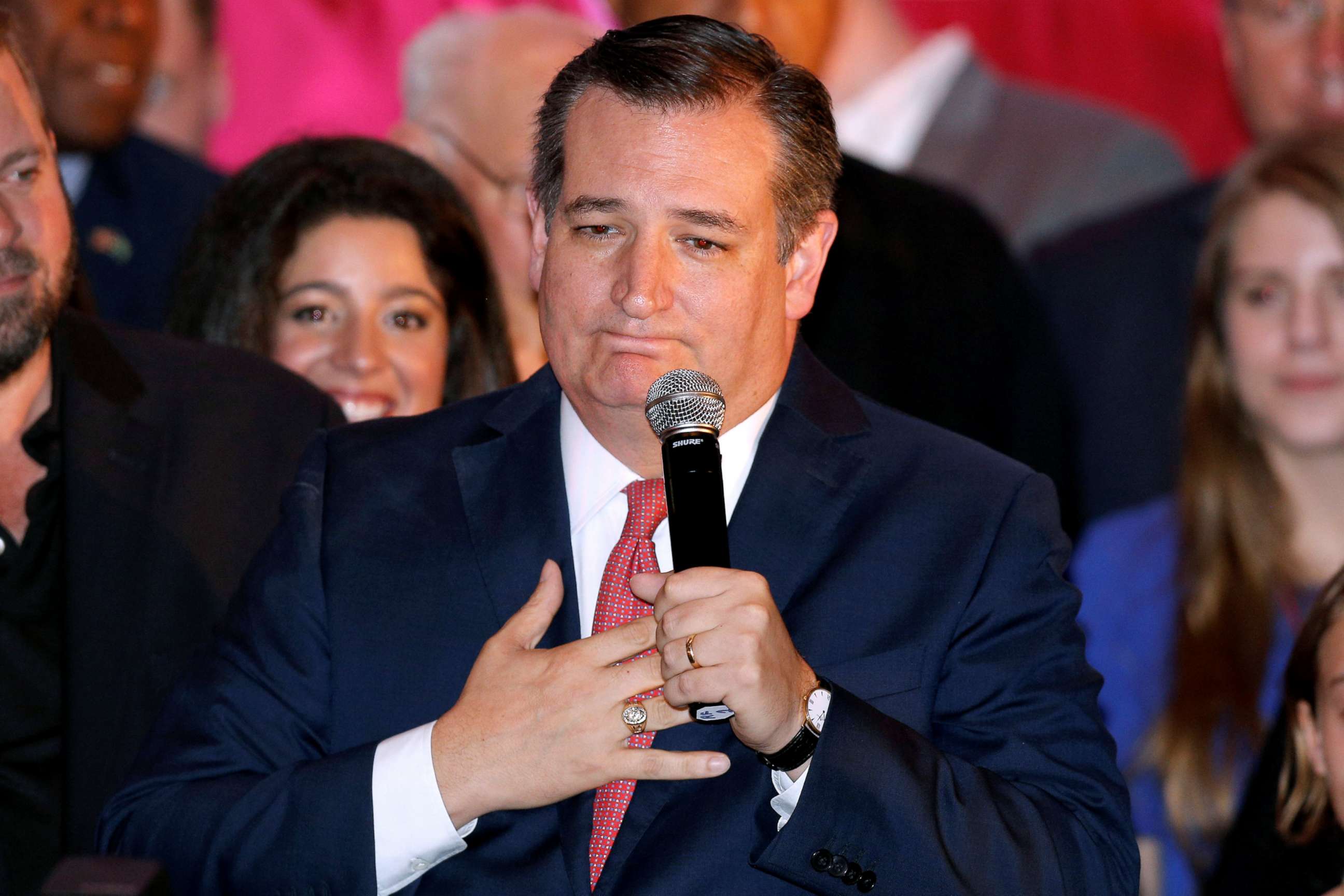
Men voted for Cruz by a 15-point margin, 42-57 percent, compared with women’s 7-point margin, 53-46 percent, for O’Rourke.
White college-educated women, 13 percent of Texas voters, divided 49-49 percent O’Rourke-Cruz.
Fifty-nine percent said Cruz’s vote in favor of Kavanaugh was a factor in their vote, they broke 40-60 percent O’Rourke-Cruz.
Nonwhites account for 41 percent of Texas voters, including 24 percent Latinos. These are highs in Texas midterms in available exit polls back to 1984, and are at or near their record levels, 43 and 24 percent, in the 2016 presidential election.
Texas Republicans outnumbered Democrats by 9 points in the 2016 presidential election and 12 points in the 2014 midterms. Today it’s a 5-point gap, 33-38 percent, Democrats-Republicans. (The last time a Democrat won a Senate seat in Texas, in 1988, turnout was +5 Democrats over Republicans.)
Texas voters divide 46-49 percent on whether they’d rather see the Democrats or the Republicans control the Senate.
Turnout among liberals, 21 percent, is at a new high – but there are far more conservatives, 43 percent, voting in Texas in this election.
Forty-two percent of voters say Beto O’Rourke (D) is too liberal, vs. 38 percent who say Ted Cruz (R) is too conservative. O’Rourke’s favorability rating is 51-41 percent; Cruz’s, 52-46 percent.
Thirty-three percent in the longest-border state call Donald Trump’s immigration policies “about right,” and voters divide 48-48 percent on whether they support or oppose a wall across the entire U.S. border with Mexico. Asked the top issue in the vote, 32 percent choose immigration among four issues given, compared with 23 percent nationally.
Independents in Texas voted Republican by a 37-point margin in the 2014 midterms. They’re +5 for O’Rourke, 51-46 percent, in these preliminary results.
Voters focused on health care – 37 percent of the electorate – are voting 68-31 percent, O’Rourke-Cruz. It’s the 1st-ranked issue out of four in Texas. Among immigration voters, by contrast, it’s 24-75 percent
While conservatives predominate, a substantial 36 percent of Texas voters are moderates. They’re voting 64-34 percent, O’Rourke-Cruz.
Among the 62 percent of voters in gun households, it’s 37-62 percent, a wide Cruz lead.
Twenty-two percent cast a ballot for the first time in a midterm election today, the most of any of the 21 states with exit polls today. They’re voting 52-45 percent, O’Rourke-Cruz.
Thirteen percent are younger than 30, voting 71-29 percent, the largest Democratic margin among this group in available exit polls back to 1984, and surpassing their margin in the 2016 presidential election by 23 points. By contrast, seniors, 29 percent of the electorate, are voting 42-58 percent.
Nonwhites are voting 69-30 percent, O’Rourke-Cruz. That includes Latinos, 63-35 percent – their largest Democratic margin since 2006 - and blacks, 90-9 percent.
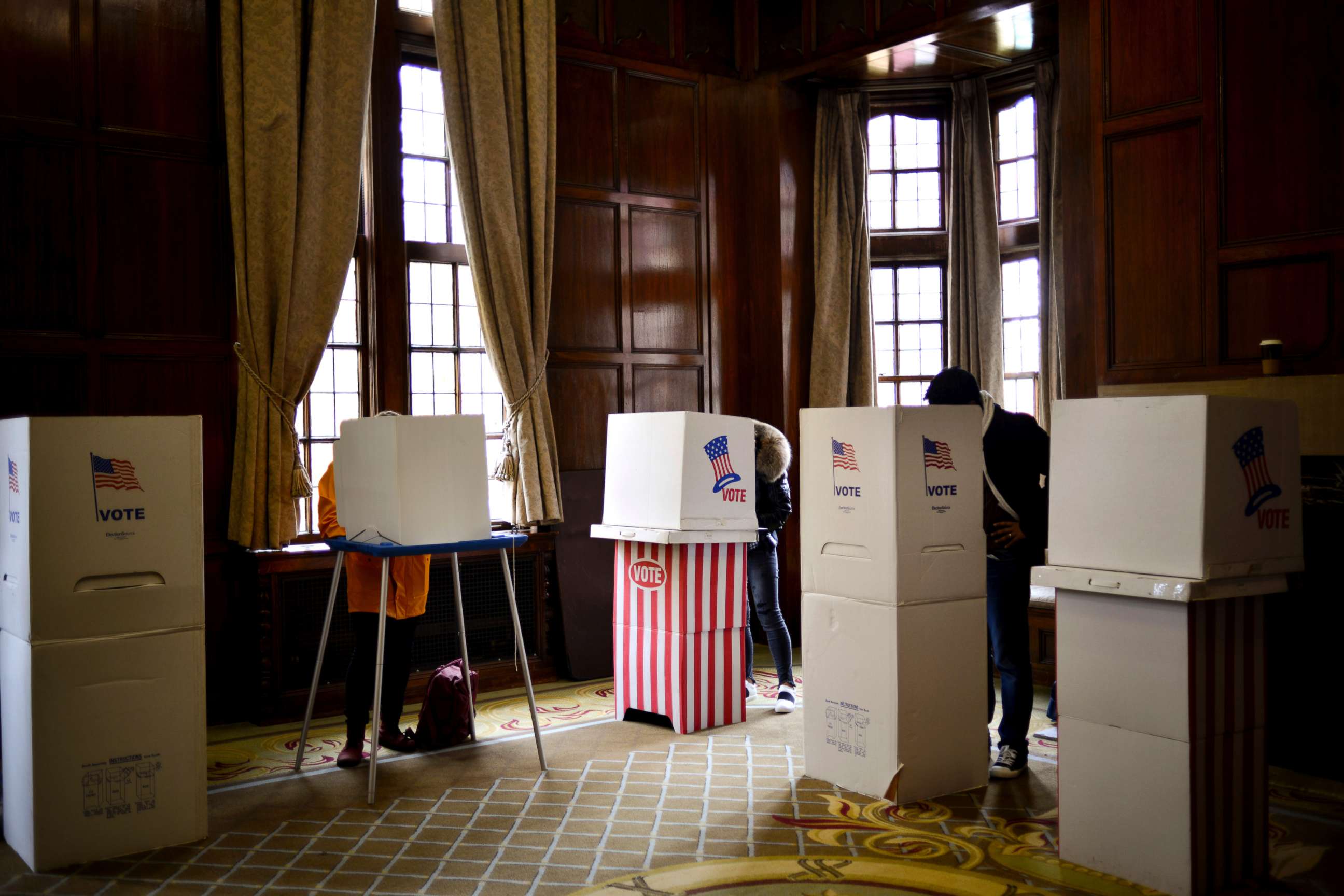
Wisconsin governor's race
Forty-seven percent of voters prefer to keep incumbent Scott Walker’s (R) signature 2011 law eliminating most collective bargaining for public employees; 41 percent would like to see it repealed. (17 percent are from union households, a new low.)
Tony Evers (D) is more personally popular than Walker, who’s seeking his third term. Evers has a 53-41 percent favorability rating, compared with 48-51 percent for Walker – 10 points higher on unfavorability.
Turnout divides 35-33 percent, Democrats-Republicans, in these preliminary results. That 2-point gap is similar to the last two gubernatorial elections (+1R in 2014, +1D in 2010).
In a state that narrowly went for Trump in 2016, he has a 46-53 percent job approval rating.
While just 16 percent of the electorate, nonwhite voters are making up their largest share of voters in available exit polls for Wisconsin gubernatorial races since 1994.
Walker won independents by double-digits in his previous gubernatorial victories; in this election Evers is winning them, 54-44 percent.
Walker lost moderate voters by 6 points in 2010 and 13 points in 2010. Tonight he’s losing them by more, 19 points, 59-40 percent.
Critics of the state’s controversial collective bargaining law, 41 percent of all voters, are backing Evers over Walker by 76-22 percent. Union voters are going 59-38 percent, Evers-Walker; Walker’s 21-point deficit in this group is narrower than in either 2014 (31 points) or 2010 (26 points).
Non-college white men are voting broadly for Walker, 40-58 percent.
Walker’s favorable rating is 49 percent; Evers’, 50 percent.
Turnout divides 34-34 percent, Democrats-Republicans. Walker won slightly more Democrats than Evers won Republicans. But Evers comes back among independents by 7 points, 52-45 percent.
Evers is buoyed by nonwhites. While just 17 percent of the electorate, they are making up their largest share of voters in available exit polls for Wisconsin gubernatorial races since 1994. Evers is winning about three-quarters of them. Walker’s margin is 45-54 percent among white voters.
Critics of the state’s controversial collective bargaining law, 38 percent of all voters, are backing Evers over Walker by 78-19 percent. However, Walker comes back with a similar advantage among the 48 percent who support it.
Union voters are 18 percent of voters, a new low. Evers is winning them, 55-41 percent, but this 14-point deficit is narrower than Walker had in either 2014 (31 points) or 2010 (26 points).
Michigan governor's race
Democrat Gretchen Whitmer is on track to win the Michigan gubernatorial race, ABC News projects, based on exit polls.
Whitmer won independents, 50-45, a group which previously went for Donald Trump by 16 points and outgoing governor Rick Snyder (R) by 27 points
While Hillary Clinton lost white women by 8 points in 2016, Whitmer won them by 14 points, 56-42. Among black women, the margin is 93-4, Whitmer-Schuette.
Fifty-eight percent of Michigan voters trust Gretchen Whitmer (D) to handle the state’s safe-drinking water issue; just 30 percent trust Bill Schuette (R) to handle it.
In a state that narrowly went for Trump in 2016, his job approval is now 42-57, one of the lowest in the 21 states with exit polls tonight.
With Whitmer seeking to become Michigan’s second female governor, 79 percent of voters say it’s important for more women to be elected to public office. About 8 in 10 men and women alike say it’s important.
Voters in Michigan are about as likely to say Donald Trump’s trade policies have hurt their local economy as to say they’ve helped, 32-30 percent. And while 64 percent of voters say the national economy is in good shape, fewer, 36 percent, say they are personally better off financially since Trump took office.
Forty-six percent of Michigan voters named health care as the top issue facing the country—more than twice as many as named the economy (20 percent) or other issues asked about. This was a winning issue for Whitmer, with those concerned about health care voting 79-19, Whitmer-Schuette.
Georgia governor's race
In preliminary exit poll results, turnout among nonwhites is a record 40 percent, including 30 percent black voters. The previous high among nonwhites was 36 percent in 2014 – compared with just 18 percent in 1994.
Forty-two percent of voters are conservatives, which is typical in Georgia. Liberals account for 20 percent, a new high for a gubernatorial election if it holds. It was 17 percent in 2014.
Thirty-nine percent say Stacey Abrams (D) is too liberal; 36 percent say Brian Kemp (R) is too conservative.
Donald Trump’s approval rating is 51 percent among Georgia voters, 7 points better than his overall approval nationally. 20 percent say they’re voting to show support for Trump; 15 percent, to oppose him.
Seventy percent call it important to elect more women to public office; that compares with 78 percent nationally.
There's greater concern about voter suppression than voter fraud, 51-41 percent, a key topic in this contest.
While the women’s vote gets a lot of attention, men in Georgia are splitting about evenly, 46-49, Abrams-Kemp. In the last two gubernatorial elections for which we have exit polls (2014 and 2006), the winning Republican candidates won men by 60-37 and 61-34 percent.
Independents, historically a swing voter group in Georgia, divide 55-41 percent, Abrams-Kemp.
Georgia’s suburban voters are voting 43-54 percent, Abrams-Kemp – including advantages for Kemp among suburban women (46-53 percent) and suburban men (40-54 percent) alike.
Libertarian Ted Metz has 3 percent support, worth watching because Georgia requires candidates to get more than 50 percent of the vote to win an election.
College-educated voters in Georgia are voting 55-43, Abrams-Kemp. This 12-point advantage is the largest Democratic lead in any midterm exit poll conducted in Georgia to date.
Indiana Senate race
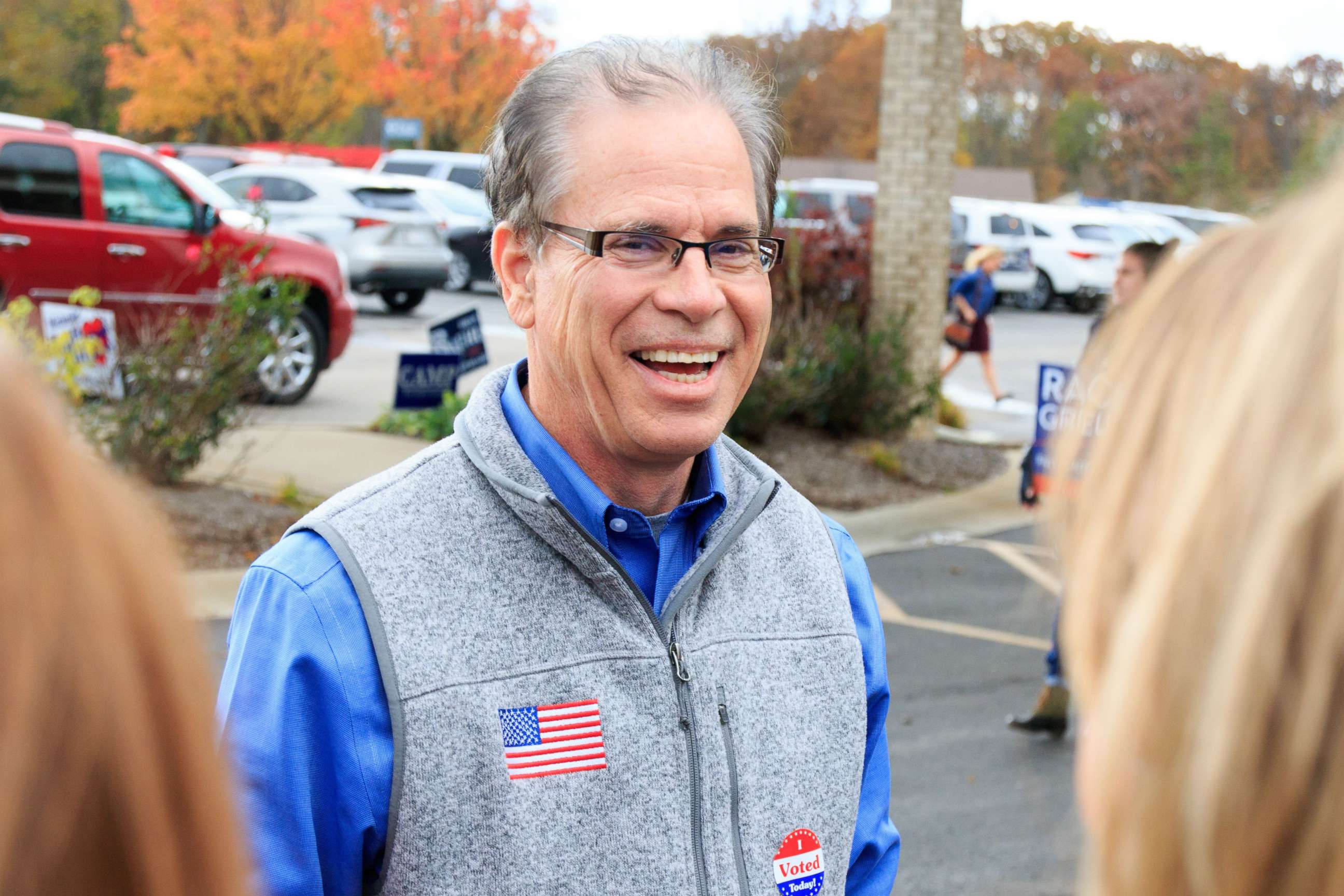
Democrat Joe Donnelly has conceded the Indiana Senate race to Republican Mike Braun.
The race was a test case for Kavanaugh impact: 53 percent call incumbent Donnelly’s (D) vote against Brett Kavanaugh’s confirmation important in their vote; 19 percent call it a minor factor, 22 percent not a factor at all. We’ll see how they voted after the polls close.
Donald Trump has a 52-48 percent approval rating in a state he won by 19 points in 2016. (Native son Mike Pence has a 54-43 percent favorability rating.) Thirty percent say they’re voting to show support for Trump, 34 percent to oppose him, while 32 percent say he’s not a factor.
Seventy-three percent of Hoosier voters say the national economy is doing well but local conditions are less broadly positive. Forty-six percent say their own finances have improved since Trump took office, 36 percent say they’ve benefited from the Trump tax law and 29 percent say his trade policies have helped their local economy.
Forty-two percent say health care is the top issue of four facing the country. And voters divide 50-44 percent on which party, the Democrats or the Republicans, would better protect pre-existing condition coverage.
Trump’s pushed immigration hard -- but it’s the top issue to just 26 percent, far trailing health care. (The economy comes in at 21 percent.) More say that his immigration policies are too tough, 41 percent, than about right, 34 percent, or not tough enough, 21 percent.
Donnelly won his seat in 2012 partly on the strength of an 11-point victory among independent voters. Independents are voting 52-40 percent between Donnelly and Mike Braun (R) in preliminary results tonight. They account for 32 percent of voters – if it holds, a new high in available exit poll data.
Donnelly ran evenly among men in 2012. Today they’re voting 42-54 percent, Donnelly-Braun.
Suburban voters divide 48-49 percent, Donnelly-Braun. Donnelly won suburbanites by a scant 2 points in 2012; in 2016, fellow Democrat Evan Bayh lost suburbanites by 17 points and lost the race. Suburban women are voting 52-43 percent, compared with suburban men, 43-54 percent.
Health care/immigration showdown: The vote is 74-22 percent Donnelly-Braun among those who picked health care as the top issue of four; that compares with 11-84 percent among the 26 percent who picked immigration as the top issue.
Those who call Donnelly’s vote against Kavanaugh highly important divide by 41-54 percent, Donnelly-Braun.
Libertarian Lucy Brenton has 4 percent of the vote, compared with 6 percent for Libertarian Andy Horning in 2012. Indiana Democrats ran ads highlighting Brenton’s policy positions during the campaign, seeking to draw conservative votes her way.
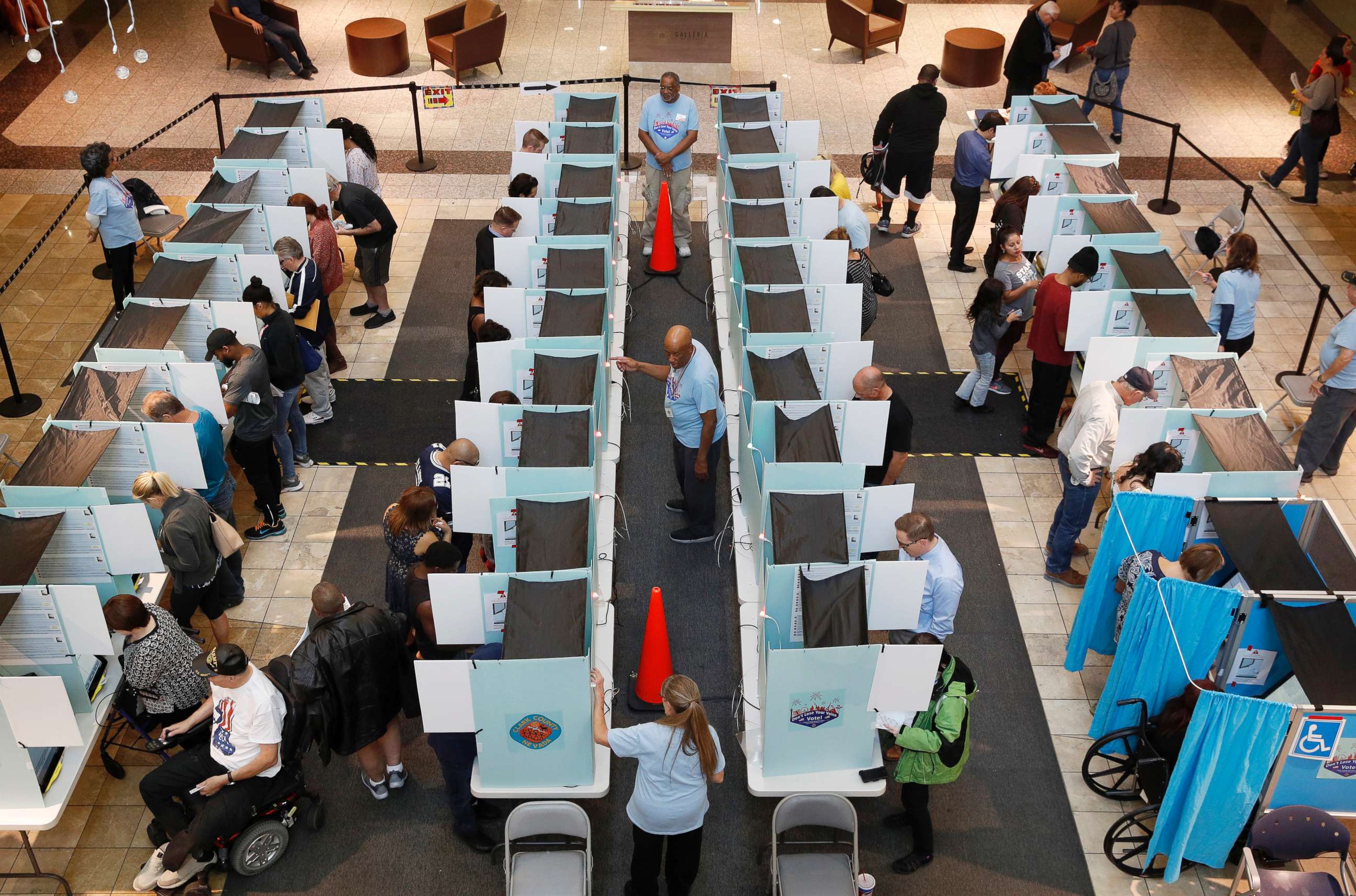
Ohio governor's race
Republican Mike DeWine is on track to win the Ohio gubernatorial race, ABC News projects, based on exit polls.
Donald Trump has a split-decision 49-49 percent job approval rating among Ohio voters today, in a state he won by 8 points in 2016. Those who strongly disapprove of Trump outnumber those who strongly approve by 7 points, 43-36 percent.
Democrats were outnumbered by Republicans among Ohio voters by 3 points in 2016, 34-37 percent, and it’s the same gap again today, 35-38 percent.
Conservatives accounted for a plurality of Ohio voters, 43 percent, in the 2014 gubernatorial race and 39 percent two years ago. Today, in data so far, they account for fewer voters, 37 percent.
The national economy is well-rated – 73 percent in Ohio say it’s in excellent or good shape, up dramatically from 34 percent in 2016 – but far fewer say Trump’s trade policies have helped their local economy (30 percent) or say his tax law has helped their own finances (28 percent).
Ohio voters pick health care as the top issue facing the country out of four choices offered; 41 percent choose it, far above the other choices. In a health-related issue – one that played prominently in the campaign – there’s vast concern about the government response to the opioid crisis – 28 percent approve, 61 percent disapprove.
Independents – often swing voters in this swing state – favored Trump over Hillary Clinton by 14 points in the presidential race two years ago. In the gubernatorial election today they’re splitting 50-46 percent, Cordray-DeWine.
Women – who favored Clinton in Ohio by a scant 3 points in Ohio in 2016 - are backing Cordray by 58-41 percent over DeWine.
Non-college white men, a GOP mainstay, are backing DeWine by a wide margin, 34-63 percent, Cordray-DeWine.
DeWine is +5 points among Suburban voters, 47-52 percent, Cordray-DeWine (no longer "dividing evenly"). That includes a wide gender gap, suburban men 40-58 percent; suburban women 54-46 percent. SIZEPLC3, SEX
In a race that focused heavily on the opioid crisis, voters who disapprove of the way the government is handling the issue favor Cordray by 57-39 percent.
Union households, while historically a Democratic group, voted for Trump by 13 points in 2016, 54-41. Tonight, representing 26 percent of voters, they are voting 52-42 percent, Cordray-DeWine.
West Virginia Senate race
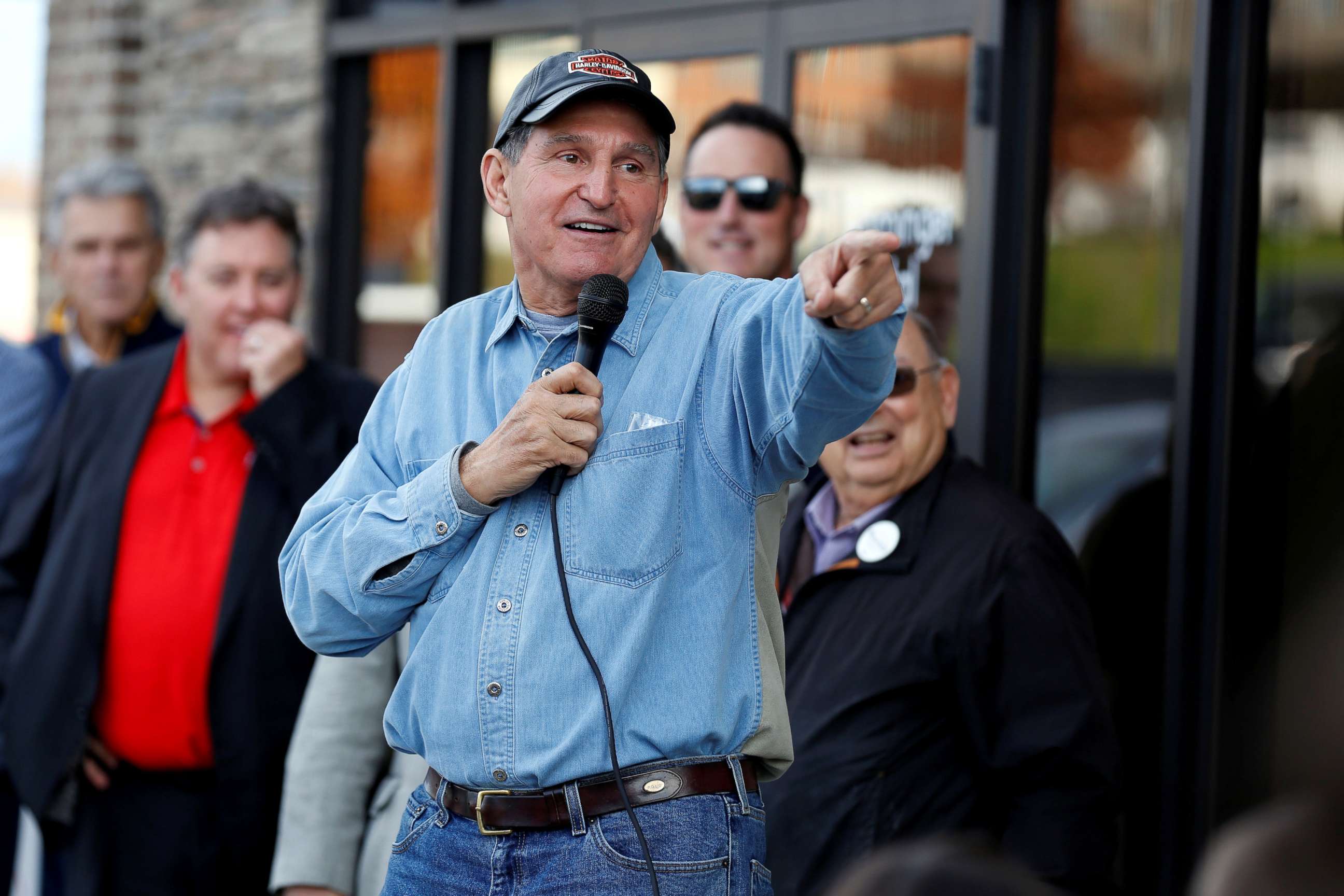
Democrat Joe Manchin is on track to win the West Virginia Senate race, ABC News projects, based on exit polls.
West Virginia voted 69-26 percent for Trump in 2016, his best state; today voters there give him a 63-34 percent job approval rating – his best approval rating in any of the 21 states where exit polls are being conducted.
In terms of basic popularity: Joe Manchin’s (D) favorability rating is 49-47 percent. Patrick Morrisey’s (R) is a weaker 40-55 percent, 15 points under water. It could matter, since 25 percent say they’re looking chiefly for the candidate who “cares about people like me.”
Democrats’ share of the West Virginia electorate has dived from 57 percent in 1996 to 32 percent now, a new low. Turnout by independents has grown – from 14 percent in 1996 to 31 percent today, a new high. Manchin won independents by 7 points in 2010, a key to his victory.
Manchin was the only Democratic senator to vote to confirm Brett Kavanaugh to the Supreme Court. 40 percent of voters say Manchin’s vote was a key factor in their Senate vote. Twenty-two percent call it a minor factor; 34 percent, not a factor at all.
Among the state’s voters overall, 40 percent say Trump’s trade policies have helped their local economy (22 percent hurt, 33 percent no impact).
Manchin slammed Morrisey for joining a lawsuit to repeal Obamacare and limit coverage for pre-existing conditions. Today 40 percent call health care the top issue (of four) in their vote, and voters divide 41-51 percent on which party, the Democrats or the Republicans, would better protect coverage for pre-existing conditions.
Manchin won independents by 7 points in 2010. He’s running even with them, 47-47 percent, in today’s preliminary results.
Among voters who call Manchin’s vote for Kavanaugh a factor in their vote today, Manchin leads Morrisey by 53-44 percent.
There’s a wide gender gap, with a broad advantage for Morrisey among men, 40-57 percent, Manchin-Morrisey.
Forty percent say they’re looking for the candidate who “shares my view of government,” the top candidate attribute, and Morrisey is winning them, 30-68 percent, Manchin-Morrisey.
Moderates. Manchin got hammered among conservatives in 2010 but won political moderates by 39 points. He’s winning them by a narrower margin, 26 points (61-35 percent) in preliminary results tonight.
Florida governor's race
Democrat Andrew Gillum has conceded the gubernatorial race to Republican Ron DeSantis.
Forty-four percent of Florida voters say Gillum (D) is too liberal, while 37 percent say DeSantis (R) is too conservative.
Liberals account for 22 percent of voters, matching their high in governor’s races in the state. Many more, 39 percent, are conservatives.
Donald Trump won Florida with 48 percent of the vote in 2017. He’s got a 51-48 percent approval rating now. Voters reject impeachment, which Gillum has supported, by 54-40 percent.
Nonwhites account for 34 percent of voters in the state, including 15 percent Hispanics and 13 percent blacks. That’s a new high for midterm elections in the state, albeit short of its 2016 record, 38 percent. While much attention is paid to the Republican-leaning Cuban-American vote, 67 percent of Hispanic voters in this election are not Cuban.
Rick Scott (R) won Florida’s suburban voters by 4 points in 2010 and 8 points in 2014. Today, they’re +6 Republican, 46-52 percent, Gillum-DeSantis, with a wide gender gap: 53-46 percent among suburban women, 39-61 percent among suburban men.
Independents, who voted for Charlie Crist (D) by a 2-point margin in his narrow 2014 loss, are now +11 points Democratic, 54-43 percent, Gillum-DeSantis. They make up 30 percent of voters today, slightly below their share in 2014, 33 percent.
Trump approvers overall are backing the president’s ally DeSantis, 8-90 percent, but among those who only “somewhat” approve of him, 14 percent of all voters, the vote is 28-65 percent, Gillum-DeSantis.
Hispanics backed Gillum by 58-39 percent and blacks by 86-14 percent, similar to their vote in 2014.
Florida Senate race
Minority voters may be key in Florida; they account for 34 percent of voters in the state, up sharply from a low of 15 percent in 1992 but less than the 38 percent who came out in 2016. That includes 15 percent Hispanics and 13 percent blacks. Among Hispanics, 32 percent are of Cuban origin, while 24 percent are Puerto Rican, following an influx from the island post-Hurricane Maria.
Forty percent say health care is the most important issue of the four asked, 29 percent immigration, 16 percent the economy and 11 percent gun policy. Voters give the Democrats an edge in trust to protect coverage for pre-existing conditions, 48-38 percent.
Sixty-seven percent of Florida voters call climate change a serious problem and say the government should do more to protect the environment, an issue used against both candidates after massive algae blooms.
Rick Scott (R) has a 46-50 percent favorability rating among voters, compared with incumbent Bill Nelson’s (D) 50-43 percent favorability. Another consideration: Florida voters divide 50-46 percent on whether they’d like to see the Democrats or the Republicans control the Senate.
On the Kavanaugh-effect front, 38 percent call Nelson’s vote against confirmation a top factor in their vote; 17 percent call it a minor factor – and 39 percent, not a factor at all.
Battle of the ‘burbs? Nelson has won the populous Florida suburbs by double-digit margins in each of his past Senate races. Scott won them by 4 points in 2010 and 8 points in 2014. It’s 46-52 percent, Nelson-Scott. That includes a 52-46 vote among suburban women, vs. 40-59 percent among suburban men.
Scott’s win in the 2014 governor’s race came via a 21-point advantage among whites. Whites tonight are voting for Scott by 19 points, 40-59 percent.
Those who think the government should do more to protect the environment are favoring Nelson by a 2-1 margin, 66-34 percent.
Health care is the top-cited issue in the state, and it’s a 75-22 percent vote in for Nelson’s favor among those with cited it. Among immigration voters, on the other hand, it’s 17-83 percent, Nelson-Scott.
Nelson's margin is +11 among Hispanics, underperforming his best (+22) and Clinton’s performance in 2016 (+27) alike.
Those who call Nelson’s anti-Kavanaugh vote a top factor divide 47-52 percent, Nelson-Scott.
Nelson is underperforming in the Tampa Bay area (16 percent of voters) compared with his 2012 run – he’s down 8 points there now, 44-52 percent, vs. 52-41 in 2012. (They split in 2016, 47-46 Clinton-Trump.)
Nelson lost men, 42-58 percent, but didn’t improve much on his margin among women from 2012, 56-42 percent now vs. 59-39 percent then.
Scott’s improved his margin among Hispanics, winning 44 percent of them now vs. 38 percent in 2014. Nelson’s 55 percent is slightly down from 59 percent in 2012.
Nelson is losing suburban voters by 4 points (48-52 percent), when he won them in 2012 by 14 points. By contrast, Scott did better among small city and rural voters than he did in 2014, netting 65 percent of their votes tonight vs. 57 percent then.
Two-thirds of Florida voters say that the economy is excellent or good, and they favor Scott by 41-59 percent, Nelson-Scott.
Health care-focused voters, 40 percent, favored Nelson by a +52 margin – but immigration and economy-focused voters (together, a larger 45 percent) swung just as hard for Scott.
Missouri Senate race
Republican Josh Hawley is on track to win the Missouri Senate race, ABC News projects, based on exit polls.
Josh Hawley’s (R) victory is thanks to a large advantage in small cities and rural areas, 30-68 percent Claire McCaskill-Hawley, and a narrow advantage in the suburbs, 48-51 percent.
Hawley’s also winning men, 46-53 percent, McCaskill-Hawley. In McCaskill’s last race (2012), she won men by eight points, 51-43 percent.
And, independents are dividing about evenly, 49-48 percent. McCaskill had won this typically swing group by 12- and 8-point margins in 2012 and 2006.
McCaskill’s (D) narrow first election in 2006 relied on her 6-point margin among women, as well as the fact that they accounted for 55 percent of voters in the state. Women make up 52 percent of Missouri voters in preliminary exit poll results tonight.
Also to watch: a conservative turnout. Conservatives accounted 37 percent of voters in 2006 when McCaskill first was elected and to 42 percent two years ago. They’re back down to 36 percent of voters in results so far tonight.
Trump’s approval rating is an even 50-49 percent in a state he won by 19 points in 2016. Thirty-one percent say they’re voting to express support for Trump, 35 percent to oppose him. That said, in a threat for McCaskill, Missouri voters divide 45-50 percent on whether they want the Democrats or the Republicans in control of the Senate.
Forty-five percent think McCaskill’s positions on the issues are too liberal, while 42 percent think Josh Hawley’s (R) are too conservative.
After two terms in office McCaskill has a 47-51 percent favorability rating; Hawley, 48-49 percent. While favorability doesn’t differentiate them, views on their ethics do: 50 percent say McCaskill has high ethical standards, while 39 percent say Hawley does.
Health care dominates as the top issue of four offered – 48 percent call it the most important of four offered; the economy and immigration tie for second with 20 percent each. Missouri voters pick the Democrats over the Republicans to better protect health care for those with pre-existing conditions, 52-44 percent.
Fifty-one percent of voters say McCaskill’s vote against Brett Kavanaugh’s confirmation was a top factor in their Senate vote. Seventeen percent say it was a minor factor; 27 percent, not a factor at all.
Turnout among independents is 32 percent in preliminary exit poll results, potentially a new high in midterms, while Democrats and Republicans are at 34 percent of the electorate apiece. With Republican and Democrat voter turnout even, McCaskill likely needs independents to hold her seat.
Independents are voting a close 49-47 percent, McCaskill-Hawley, in preliminary exit poll results. McCaskill won this typically swing group by 12- and 8-point margins in 2012 and 2006.
Suburban voters backed McCaskill by 55-39 percent in her easy 2012 race against Todd Akin (R), but she lost them, 46-52 percent, in 2006. They’re voting by the same 46-52 percent in preliminary results today. That includes a gender gap, 49-50 percent among suburban women, 44-55 percent among suburban men.
Those who call McCaskill’s vote against Kavanaugh a top factor are voting 46-52 percent, McCaskill-Hawley. At the same time, 83 percent call sexual harassment a serious problem; they’re breaking 58-42 percent in McCaskill’s favor.
Unusually for a Democrat, McCaskill won 35 percent of evangelical white Christians six years ago, vs. 24 percent in her close first election. Today they’re dividing 27-72 percent, McCaskill-Hawley.
Young voters (age under 30) account for 10 percent of voters in Missouri in preliminary results. They’re voting 63-34 percent for the Democrat – compared with 69-25 percent in her last race.
Tennessee Senate race

Republican Marsha Blackburn is on track to win the Tennessee Senate race, ABC News projects, based on exit polls.
Tennessee voters want the Senate controlled by the Republican Party, not the Democrats, by a broad 38-56 percent. It’s one of the top three states to favor Republican control (alongside Mississippi and North Dakota).
Both Tennessee Senate candidates are relatively popular: Phil Bredesen (D) has a 51-43 percent favorability rating; Marsha Blackburn (R), 55-41 percent. Then there’s Donald Trump, with a 57-40 percent approval rating among Tennessee voters, considerably better than his 44-55 percent figure nationally.
Trump visited Tennessee for Blackburn as recently as this past weekend. Could help her: 37 percent say they’re casting their vote to show support for Trump, vs. 27 percent voting to show opposition to Trump. Thirty-four percent say Trump’s not a factor.
Bredesen, a former health care executive, has focused on health care; Blackburn on immigration policy. Among voters today, 38 percent call health care the top issue of four offered; 24 percent say it’s immigration, 23 percent the economy. Trump’s tough stance on immigration gets mixed reviews; 37 percent say it’s too tough, 31 percent about right - and 27 percent not tough enough.
Thirty-eight percent of voters say Blackburn’s too conservative; 42 percent say Bredesen is too liberal.
In terms of the candidate attributes they care about, someone who shares my view of government tops the list, 37 percent.
Republicans account for 44 percent of voters so far today – more than either Democrats (26 percent) or independents (30 percent).
Independents, potential swing voters in Tennessee, are voting 56-44 percent, Bredesen-Blackburn.
Blackburn’s running competitively among women overall, with 52 percent support to Bredesen’s 48 percent. That includes a 41-59 percent result, Bredesen-Blackburn, among suburban women.
Bredesen’s found votes in his focus on health care; among those who call it their top issue, he leads Blackburn by 72-28 percent. Then again, those calling immigration the top issue vote 18-82 percent, with Blackburn ahead, in preliminary results.
Sixteen percent voted for the first time in a midterm election, voting 57-43 percent Bredesen-Blackburn.
Mississippi Senate race
If Mike Espy (D) gets into a runoff, his life won’t be easy: in a hypothetical head-to-head, voters divide 41-51 percent between Espy and incumbent Cindy Hyde-Smith (R).
Nonwhites account for 36 percent of voters in Mississippi, including 31 percent blacks. Black turnout is up by 8 points from its low of 23 percent in 1988, though off its peak of 35 percent in 2012.
Conservatives typically dominate in Mississippi. In preliminary results today, they’re at 51 percent of the electorate, the most of any state with exit polls this election.
Donald Trump is popular in MS, with a 61-38 percent approval rating, and 40 percent say they’re casting their ballot to show support for Trump. Both are among the highest of any state in the 21 where we have exit polls.
With Hyde-Smith the only woman among the four most prominent candidates, voters by 75-24 percent say it's important that more women be elected to public office.
Demonstrating racial divides, 65 percent of black voters in Mississippi say whites are favored over minorities in the United States today. Seventeen percent of white voters agree.
In terms of top issues, 40 percent pick health care of four offered, 24 percent the economy, 23 percent immigration and 10 percent gun policy, similar to national results.
Among those casting their ballots to show support for Trump, Hyde-Smith has 59 percent support, compared with Chris McDaniel’s (R) 36 percent. Trump endorsed Hyde-Smith.
Women are dividing 46-34-17 percent for Espy, Hyde-Smith, and McDaniel.
Among voters focused on health care, Espy leads Hyde-Smith 59-26 percent. Among those focused on the economy, it’s 30-56 percent, Espy-Hyde-Smith.
New Jersey Senate race
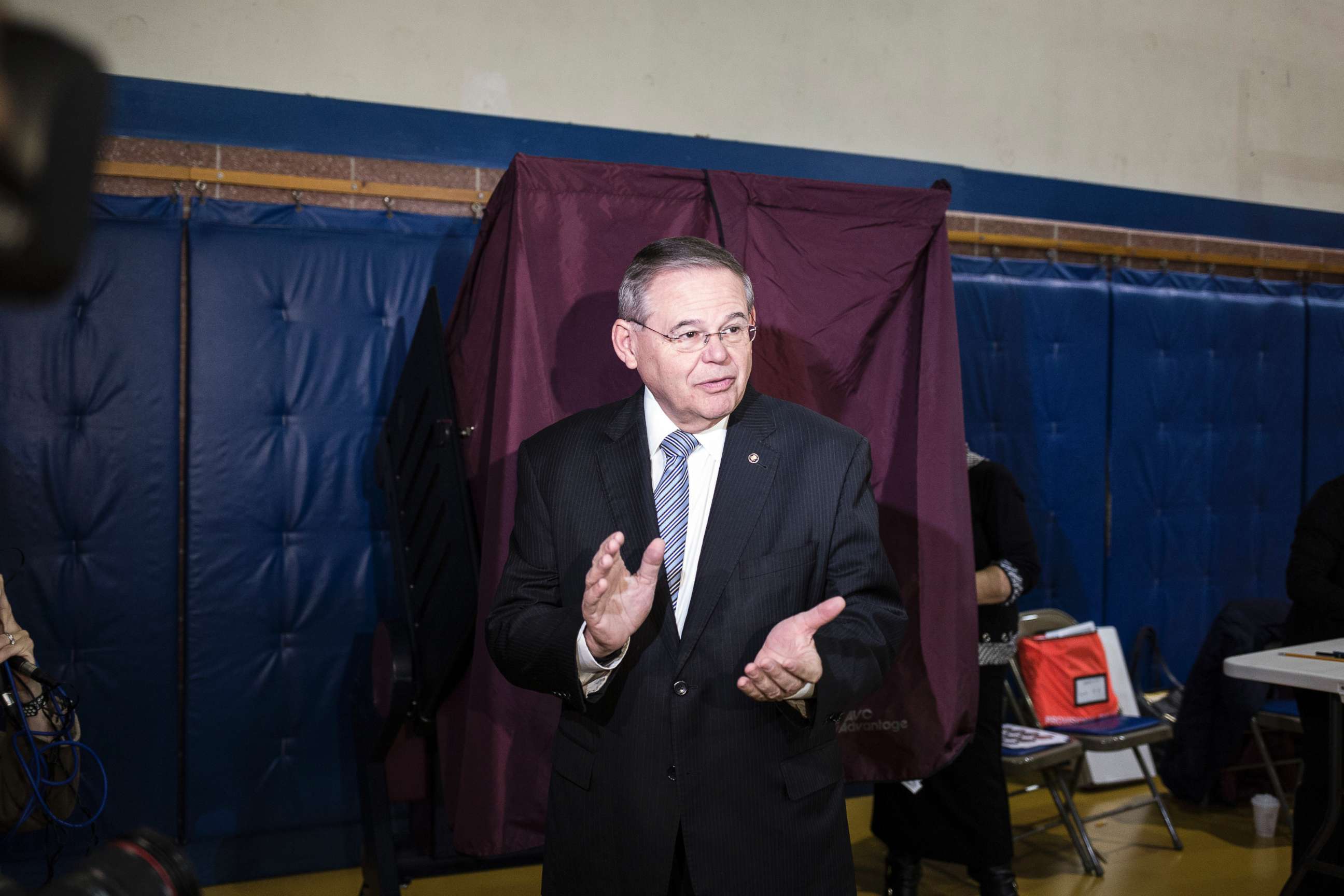
Bob Menedez is on track to win the New Jersey Senate race, ABC News projects, based on exit polls.
Bob Menendez’s (D) victory is largely thanks to the 55 percent of New Jerseyans who want to see control of the Senate flipped – highest among the 18 states where it was asked on exit polls tonight. Among this group, voters overwhelmingly chose Menendez over Bob Hugin (R), 93-6 percent.
Additionally, among the 60 percent who disapprove of Trump’s job performance, Menendez beat Hugin by 83-14 percent.
Menendez (D) is broadly unpopular, with a 33-63 percent favorability rating. Bob Hugin (R) is underwater in favorability as well, but not so broadly, 42-52 percent.
Relatedly, just 27 percent say Menendez has high ethical standards. Twice as many say Hugin has high ethical standards, 45 percent. 33 percent of voters say neither has high ethical standards.
Helpfully for Menendez, given those challenges, New Jersey voters say they want to see the Democrats win control of the Senate, 58-39 percent. Independents divide 59-36 percent on the question.
Donald Trump has a 41-59 percent approval rating in the state, among his worst in the 21 states with exit polls tonight. Forty-seven percent say he should be impeached, more than the 41 percent who say the same nationally.
Menendez lost whites by 10 points in 2012 but was elected on vast support from nonwhites. They accounted for a record 33 percent of voters then. Nonwhites make up 37 percent of voters in the state today, in preliminary results – a new high if it holds.
Menendez benefits from representing a solid blue state; Democrats account for 43 percent of voters there in today’s preliminary results, Republicans just 26 percent. Hugin needs independents to swing it. They account for 31 percent of voters in preliminary data.
Menendez is losing those who see him unfavorably by 35-62 percent. He’s also losing those who think he lacks high ethical standards, but he does win 44 percent of their votes nonetheless.
Menendez ran evenly among independents in his first election in 2012. Today, independents are backing him over Hugin by 6 points, 51-45 percent, in preliminary exit poll results.
Arizona Senate race
Arizona voters prefer Republican over Democratic control of the Senate, 53-42 percent on whether they’d like the Democrats or the Republicans to control the Senate, a potential boost to Martha McSally (R) vs. Kyrsten Sinema (D).
Thirty-two percent in this border state cite immigration as the top issue of four facing the country, compared with 23 percent nationally. Still, more pick health care (41 percent) as most important. Donald Trump’s immigration policies are seen as “about right” by 41 percent, vs. too tough (35 percent) or not tough enough (17 percent). Nationally, his policies are seen as “about right” by fewer, 32 percent.
Conservatives can dominate in this state, but their share of the electorate fluctuates -- 41 percent two years ago, down from a high of 46 percent in 2010. Conservatives again account for 41 percent of voters in preliminary exit poll results tonight. Liberals -- who turned out at a record 27 percent of voters in the state in 2016 -- make up 22 percent in preliminary results today.
Forty percent in the state say Sinema is too liberal, while 38 percent say McSally is too conservative.
Trump has a 52-47 percent approval rating in the state, which he won by 4 points in 2016. Twenty-six percent say they’re voting to express support for Trump, 28 percent to express opposition, while 44 percent say he’s not a factor.
For all the “referendum on Trump” angles, there’s another group to watch – the 44 percent of Arizona voters who say Trump is not a factor in their vote. They’re breaking 42-58 percent, Sinema-McSally.
McSally’s overwhelmingly is winning voters focused on the issue of immigration, 16-84 percent, Sinema-McSally. Those focused on health care, by comparison, are voting 77-22 percent.
Independents account for 30 percent of Arizona voters so far tonight; in 2012 Jeff Flake (R) ran essentially evenly in this group (-1 point) to win this Senate seat. Today, independents are dividing evenly, 49-49 percent.
Veterans -- 14 percent of the electorate -- go broadly for McSally, 37-61 percent, Sinema-McSally.
Kyrsten Sinema (D) is helped by a 27-point margin among moderates (63-36 percent, Sinema-McSally) -- the largest pro-Democratic candidate margin in an Arizona Senate race in exit poll data dating back to 1994. (The next largest was 16 points in 2012.)
Martha McSally (R) strikes back by winning the 44 percent who say Donald Trump isn’t a factor in their vote, 42-58 percent, McSally-Sinema.
Voters 65 and older (29 percent of Arizona voters) split dead even: 50-50 percent, Sinema-McSally.
Montana Senate race
For all his visits, 54 percent of voters say Donald Trump is not a factor in how they cast their ballot for Senate -- more in any other state in which the question was asked. Tester is winning big among those voters, 57-41 percent. Still just 26 percent say they’re voting to show support for Trump -- and 19 percent to oppose him -- leaving 54 percent saying the president, for all his visits, is not a factor.
Voters are more apt to say they’d like to see the Republicans than the Democrats control the Senate, 50-42 percent.
Incumbent Jon Tester (D) has a 49-48 percent favorability rating, compared with Matt Rosendale’s (R) weaker 41-53 percent. At the same time, 47 percent say Tester is too liberal, while 41 percent say Rosendale is too conservative.
Independents predominated in Montana when Tester won his seat in 2012, accounting for 41 percent of voters. In today’s results they’re 45 percent of the electorate, maintaining their central importance in the outcome. (Republicans are 29 percent of voters; Democrats, 26 percent.)
Forty-five percent say Tester’s vote against Brett Kavanaugh’s confirmation is an important factor in their vote; 53 percent of women say so, vs. 37 percent of men.
Tester is winning women by 19 points, 58-39 percent, double his +9 margin among women in 2012. He won white women by 6 points in 2012; his margin among white women tonight is nearly three times as large, 58-39 percent.
Voters chiefly are looking for a candidate who “shares my view of government” -- 57 percent say so, more than twice as many as say they care most about a candidate who “cares about people like me” -- 24 percent.
Forty-six percent of voters name health care as the top issues facing the country, among four choices. The economy and immigration trail (24 percent and 21 percent).
The 54 percent of voters who say Trump was not a factor in their vote are dividing 57-41 percent, Tester-Rosendale.
Those who say Tester’s opposition to Kavanaugh was an important factor in their vote divide 31-66 percent, Tester-Rosendale.
Tester won independents by 10 points six years ago. It’s a similar 52-43 percent, Tester-Rosendale, now.
Tester is winning big among moderates, 70-26 percent; they account for nearly four in 10 Montana voters (38 percent). This 44-point margin is even larger than the 32 points by which Tester won moderates in 2012.
Tester lost men by 4 points while winning women by 9 points in 2012. Today he’s losing men by 8 points, 46-52 percent.
Nonwhites account for 12 percent of Montana voters in these preliminary results. And, while Tester won them by a whopping 42 points in 2012, today they are dividing 49-50 percent, Tester-Rosendale.
Tester is winning the under 30 voters by a massive 43 points, 70-27 percent, compared with the 8-point margin he won them by in 2012.
Eighty-one percent of Montana voters live in a gun-owning household – more than in any of the 10 states where the question was asked. And a big number. They’re voting 52-46 percent for Tester over Rosendale.
Nevada Senate race
Forty-four percent call Jacky Rosen (D) too liberal; 39 percent call Incumbent Dean Heller (R) Heller too conservative.
Fifty-seven percent call Heller’s vote to confirm Brett Kavanaugh a top factor in their vote, about equal numbers of men and women alike.
Heller is the only incumbent Republican senator running in a state Hillary Clinton won in 2016. Voters today divide 49-51 percent on Trump’s job performance. While 34 percent say they’re voting to show support for Trump, 38 percent who are voting to oppose him.
Voters divide 48-47 percent in these preliminary results on whether they want the Democrats or the Republicans to control the Senate.
Whites account for 62 percent of Nevada voters in preliminary results, nonwhites 38 percent – a record for nonwhites in midterms in the state. That includes 18 percent turnout by Latino voters – also, if it holds, a new midterm high.
Twenty-three percent of voters are from union households, up 4 points from 2016.
Today in preliminary results the electorate is 34-37 percent, Democrat-Republican. Democrats outnumbered Republicans by 8 points in 2016 and by 9 points in 2012, when Heller won his seat.
Heller lost women by 6 points in 2012, while winning men by 10. He’s losing women by 23 points today, 59-36 percent, Rosen-Heller.
Independents are voting 58-35 percent, Rosen-Heller – a group Heller won by 20 points in 2012.
Voters who say Heller’s pro-Kavanaugh vote is a top concern are dividing 49-49 percent, Rosen-Heller.
Heller won in 2012 by winning by 32 points in rural counties; he’s +40 points in preliminary results today.
This is a developing story. Please check back for updates.
ABC News Live — the network’s 24/7 breaking news and live events streaming channel —will offer continuous and commercial free coverage on Election Day starting at 4:30 p.m. ET on Roku, AppleTV, Amazon Fire TV, YouTube, Apple News, Facebook, Twitter and the ABC News site and mobile phone apps. ABC News will also provide comprehensive coverage, analysis and race updates on ABCNews.com, FiveThirtyEight.com and GoodMorningAmerica.com. Daily newscast “On Location” will feature segments on the midterms before, during and after Election Day — exclusively on Facebook Watch.




